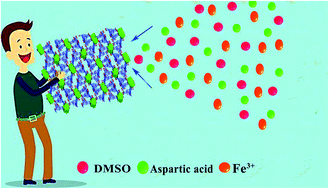First Ln-MOF as a trifunctional luminescent probe for the efficient sensing of aspartic acid, Fe3+ and DMSO†
Abstract
Five 3D network Ln3+ metal–organic frameworks (Ln-MOFs) formulated as [[Ln(μ6-H2cpboda)(μ2-OH2)2]·xH2O]n [Ln3+ = La3+ (1), Nd3+ (2), Sm3+ (3), Eu3+ (4), Tb3+ (5), H2cpboda = 5,5′-((5-carboxy-1,3-phenylene)bis(oxy))diisophthalic acid] were synthesized via a hydrothermal method. They were established by single-crystal X-ray and powder diffraction analyses, elemental analysis (EA) and thermogravimetric analyses (TGAs). All the compounds are isostructural with three-dimensional structures with the point symbol of (413·62)(48·66·8) in terms of topology, and they crystallize in the monoclinic space group P21/n. Interestingly, the solid-state luminescence of complexes 4 and 5 shows intense red and green emission, respectively. Besides, the Tb-MOF (5) is a good luminescent sensor, able not only to detect aspartic acid and Fe(III) ions with good stability, high efficiency and reversibility, but also to exhibit a rapid response and high selectivity to DMSO. To our knowledge, it is the first Ln-MOF that can act as a luminescent probe for the efficient sensing of DMSO, while the lone pair of electrons in the O of DMSO attacked the positive charge at the protonation carboxylic acid of H5cpboda. Consequently, Tb-MOF (5) is a rare and versatile fluorescent probe for aspartic acid, Fe3+ cations and DMSO, simultaneously.

- This article is part of the themed collection: Spotlight Collection: MOF Sensors


 Please wait while we load your content...
Please wait while we load your content...